OFDM as Applied by 802.11a
802.11a is not a radical application of OFDM. The task group responsible for standardizing OFDM took the middle ground to apply OFDM to wireless LAN.
OFDM Parameter Choice for 802.11a
When choosing OFDM parameters, there are usually three given items of information. Bandwidth is fixed, often by regulatory authorities. Delay is determined by the environment in which the OFDM system will operate; most office buildings generally show a delay spread of 40-70 ns, though in some environments, the delay spread can approach 200 ns. Finally, the bit rate is usually a design goal, although the goal is usually "make the bit rate as high as possible, given the constraints of the other parameters."
One common guideline is that the guard time should be two to four times the average delay spread. As a result, the 802.11a designers selected a guard time of 800 ns. Symbol duration should be much larger than the guard time, but within reason. Larger symbol times mean that more subcarriers can fit within the symbol time. More subcarriers increase the signal-processing load at both the sender and receiver, increasing the cost and complexity of the resulting device. A practical choice is to select a symbol time at least five times the guard time; 802.11a matches the 800-ns guard time with a 4-ms symbol time. Subcarrier spacing is inversely related to the FFT integration time. 802.11a has a 3.2-ms integration time and a subcarrier spacing of 0.3125 MHz (1/3.2 ms).
Operating channels in 802.11a are specified as 20 MHz-wide. The bandwidth of an operating channel is a design decision. Wider operating channels have higher throughput, but fewer operating channels fit into the assigned frequency spectrum. The use of a 20-MHz operating channel allows for reasonable speeds on each channel (up to 54 Mbps), as well as a reasonable number of operating channels in the assigned spectrum. 802.11a offers a wide variety of choices in modulation and coding to allow for a trade-off between robust modulation and conservative coding, which yields low, reliable throughput, finer-grained modulation, and aggressive coding, resulting in higher, yet somewhat more fragile, throughput.
Structure of an Operating Channel
Like the DS PHYs, the OFDM physical layer organizes the spectrum into operating channels. Each 20-MHz channel is composed of 52 subcarriers. 4 of the subcarriers are used as pilot carriers for monitoring path shifts and ICI, while the other 48 subcarriers are used to transmit data. Subcarriers are spaced 0.3125 MHz apart. As shown in Figure 13-8, channels are numbered from -26 to 26. Subcarrier 0 is not used for signal-processing reasons.
Pilot subcarriers are assigned to subcarriers -21, -7, 7, and 21. To avoid strong spectral lines in the Fourier transform, the pilot subcarriers transmit a fixed bit sequence specified in 802.11a using a conservative modulation technique.
Figure 13-8. Structure of an OFDM channel

Subchannel modulation techniques
802.11a uses a technique called quadrature amplitude modulation (QAM) on each of the subcarriers to transmit data. QAM encodes data on a single carrier wave, but that carrier wave is composed of two components, called the in-phase and quadrature components. QAM performs amplitude modulation on both components; that is, it varies the size of the carrier wave based on the input. The main carrier wave is called in the in-phase component, abbreviated I. Lagging behind a quarter-cycle out of phase is the quadrature component, abbreviated Q. (Alternatively, QAM can be modeled mathematically as a single wave by using complex numbers.) Essentially, the amplitude of the composite signal and phase shifts within it both encode information.[*]
[*] The phase shift modulation used by direct-sequence 802.11 PHYs is a special case of QAM, where the amplitude does not change but the phase does.
QAM is widely used in radio transmission systems. In North American television transmission, the in-phase component carries luminance, or brightness information, while the quadrature component carries the color information. AM radio is capable of stereo reception as well; a QAM system system called C-QUAM encodes the stereo information on the quadrature component.
Both television and radio are analog systems. In digital systems, the in-phase and quadrature components are restricted to particular levels, or quantized. With both components restricted to a particular set of levels, the result is that a constellation is formed. Constellations are usually displayed by plotting allowed values of the in-phase signal and quadrature signal against each other on a two-dimensional plot. Each point in the constellation is assigned to a symbol, and each symbol is assigned to a specific bit value. QAM is described in writing with the number of bits in the constellation, such as 64-QAM. Because the number of quantized values should always be a multiple of two in each direction, the number preceding QAM is always a power of two. 802.11a uses square constellations, and many of the proposals for faster codes use square constellations as well, which means that both directions must be an even power of two, and the number is also a perfect square (16-QAM, 64-QAM, 256-QAM).
To transmit data at higher rates, define a constellation with more points. However, as the data rate increases, the received signal quality must be good enough to distinguish between adjacent points in the constellation. As they are packed closer together, the acceptable error range around a point shrinks. 802.11a specifies the maximum acceptable errors from a constellation point as part of the PHY. Figure 13-10 shows the constellations used by 802.11a. At the lowest bit rates are BPSK and QPSK, the two phase-shift keying modulations used by the direct sequence PHYs.
Figure 13-9. Constellations used by 802.11a
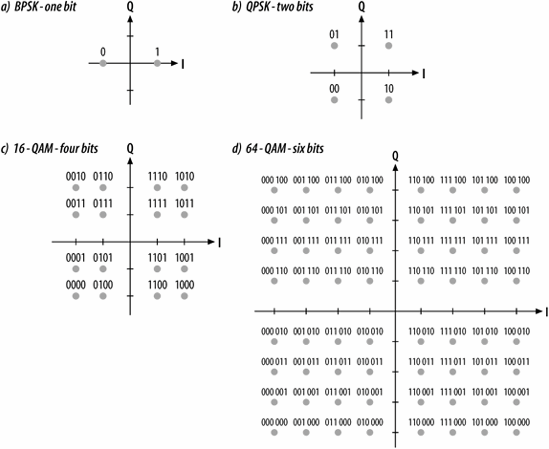
The total capacity of the radio channel is obtained by multiplying the number of subchannels by the number of bits per channel. A radio channel using 64-QAM on each subchannel can carry six bits per subchannel. In 802.11a, there are 48 subchannels, which gives a capacity of 288 bits per channel. However, there is a second attribute to account for. Most radio channels are not capable of error-free operation, and incorporate an error correction code.
Forward error correction with convolutional coding
Strictly speaking, forward error correction is not part of OFDM. However, OFDM is used in applications for which the signal is subject to narrowband interference or frequency-specific narrowband fading, also known as deep fading. When fading occurs, a channel's ability to carry data may go to zero because the received amplitude is so small. To keep a few faded channels from driving the bit error rate to the sky, OFDM implementations often apply an error correction code across all the subchannels. Implementations that use an error correction code in conjunction with OFDM are sometimes called coded OFDM (COFDM).
Coded OFDM uses a forward error correction (FEC) code on each channel. Forward error correction is a system that allows a receiver to detect corrupted bits and repair the transmission, provided that the fraction of lost or damaged bits is small enough. To provide the error-correction capability, redundant bits are added to the data stream. FEC codes work by creating a state engine that depends on the data bits currently being transmitted and encoding them across several symbols. By smearing noise out through several transmitted symbols, transient noise may be reduced to the point where resulting errors do not affect the receiver's ability to reconstruct the bit stream.
Two classes of forward error correction codes can be used. Block codes work by taking input blocks of a fixed size, while convolutional codes work on streams of any length. Block codes are used for applications in which the data is naturally stored, transmitted, or processed in chunks. DVDs, CDs, and hard disks use a block code. Convolutional codes, however, are the easy choice for wireless LANs because the frames being transmitted may be a variety of sizes.[*]
[*] In 1993, it was discovered that two convolutional codes can be combined into a turbo code. Turbo codes are extremely powerful, though at the cost of additional latency over convolutional codes. They are used in applications where the additional latency is not a major factor, such as space and satellite communications. For further information about turbo codes, see the Jet Propulsion Laboratory's site at http://www331.jpl.nasa.gov/public/JPLtcodes.html, which features overview comparing the performance of turbo codes to the error correction codes used on the Voyager and Cassini probes. Turbo codes also underpin 1xEV-DO, Qualcomm's 3G Internet access system.
Convolutional codes have two main parameters. The constraint length determines how long a data bit is averaged into successive transmissions. Longer constraint lengths average data bits (and hence, any noise) over a longer time period, improving the reliability of the transmission at the cost of more complexity in the decoder. For relatively short constraint lengths, the Viterbi algorithm is used; it is recommended by the 802.11a standard itself. One of the reasons for the recommendation is that the Viterbi decoder is a maximum likelihood decoder. The results from a Viterbi decoder are the most likely data bits that were transmitted. Not all decoders are maximum likelihood, though it is obviously an important property for digital transmission systems. 802.11a uses a constraint length of 7, which is the limit of where a Viterbi decoder can practically be used. (Complexity of Viterbi decoding grows exponentially with constraint length.)
The second parameter, the coding rate (R), determines how many redundant bits are added. It is expressed as the number of data bits transmitted as a ratio of the total number of coded bits. A convolutional code with R=1/2 transmits one data bit for every two code bits. More aggressive codes may have less redundant information, such as R=3/4, where only 25% of the bits are redundant. Selecting a coding rate is a matter of engineering. As the code rate decreases, more code bits are available to correct errors, and the code becomes more robust. However, the price of robustness is decreased throughput. 802.11a specifies three code rates ranging from 1/2 at the most conservative end to 3/4 at the most aggressive end.[*]
[*] The basic convolutional code specified by 802.11a uses a constraint length of 7 and a code rate of 1/2. This code was used on the Voyager deep-space probe.
Convolutional code rates may be transformed by puncturing. A punctured code changes a lower-rate convolutional code into a higher-rate code by discarding some of the coded bits. When data is coded, the lower-rate code is run. In the case of 802.11a, the lowest code rate is 1/2, which doubles the size of the data. To puncture to a 3/4 rate, one third of the coded data is discarded, or "punctured." To puncture to a 2/3 rate, 30% of the coded data is discarded. The coded data, minus the dropped bits, are transmitted. At the receiver, dummy bits are stuffed into the decoder to stand in for the punctured bits. Figure 13-10 illustrates the process to puncture a rate 1/2 code to a rate 3/4 code. One of the advantages of using a punctured code is that it can be implemented as single convolutional coder under software control, and different puncturing patterns can be used to alter the rate in software.
Figure 13-10. Puncturing to increase the code rate
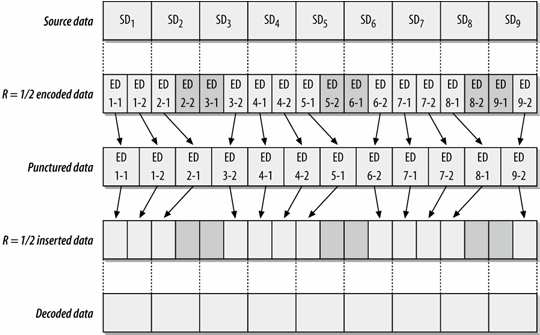
Subchannel interleaving
Each operating channel has 48 constituent subcarriers. In essence, each operating channel is a multiplexed sum of 48 separate data streams. The incoming stream of coded bits must be mapped on to the correct subcarrier. Rather than use a simple round-robin algorithm that maps the first bit on to the first subcarrier, the second bit on to the second subcarrier, and so on, 802.11a uses a pair of interleaving rules. The first rule ensures that bits in sequence are transmitted on widely separated subcarriers, and the second ensures that bits in sequence are mapped on to different constellation points. As an example, Figure 13-11 illustrates the interleaver in operation with 16-QAM, which has 192 bits. Each of the 192 bits must be mapped on to one of the 48 data-carrying subcarriers. The figure plots the bit position against the subcarrier, clearly showing how each subcarrier is responsible for four coded bits.
Figure 13-11. Interleaving with 16-QAM
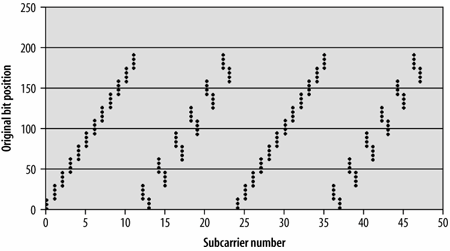
Operating Channels
Channels in the 5-GHz band are numbered starting every 5 MHz according to the following formulas:
Obviously, each 20-MHz 802.11a channel occupies four channel numbers. The recommended channel use is given in Table 13-1. 802.11a was originally designed for the United States. European channelization was added as part of 802.11h in late 2003, and Japanese operation was added with 802.11j in late 2004.[*]
[*] European radio regulations are standardized by the European Conference of Postal and Telecommunications Administrations (CEPT). The European Radiocommunications Office develops regulations for CEPT; the 5 GHz radio LAN regulations are ERC/DEC/(99)23 (available at http://www.ero.dk/doc98/Official/Pdf/DEC9923E.PDF). Japanese operation was approved by the Ministry of Internal Communications (http://www.soumu.go.jp/), in Articles 49.20 and 49.21 (http://www.soumu.go.jp/joho_tsusin/eng/Resources/Legislation/MRA/020226_00.html).
|
Frequency |
Allowed in? |
Allowed powera |
Channel numbers |
Center frequency (GHz) |
|---|---|---|---|---|
|
4.920-4.980 GHz |
Japan |
250 mW EIRP and < 1 W, or 10 mW EIRP |
240 244 248 252 |
4.920 4.940 4.960 4.980 |
|
5.040-5.080 GHz |
Japan |
250 mW EIRP and < 1 W, or 10 mW EIRP |
8 12 16 |
5.040 5.060 5.080 |
|
5.15-5.25 GHz |
Japan |
200 mW (< 10 mW/MHz) |
34 38 42 46 |
5.170 5.190 5.210 5.230 |
|
U-NII lower band (5.15-5.25 GHz) |
United States |
40 mW (2.5 mW/MHz) |
36 40 44 48 |
5.180 5.200 5.220 5.240 |
|
U-NII mid-band (5.25-5.35 GHz) |
United States |
200 mW (12.5 mW/MHz) |
52 56 60 64 |
5.260 5.280 5.300 5.320 |
|
5.470-5.725 |
Europe (CEPT) (allowed in United States as of 11/2003, subject to U-NII rulesb) |
1 W EIRP |
100 104 108 112 116 120 124 128 132 136 140 |
5.500 5.520 5.540 5.560 5.580 5.600 5.620 5.640 5.660 5.680 5.700 |
|
U-NII upper band (5.725-5.825 GHz) |
800 mW (50 mW/MHz) |
149 153 157 161 |
5.745 5.765 5.785 5.805 |
|
|
a In the United States, the allowed power is the maximum output power using a 6-dBi antenna gain. |
||||
|
b The additional spectrum was opened in FCC 03-287 (http://hraunfoss.fcc.gov/edocs_public/attachmatch/FCC-03-287A1.pdf), but test procedures were still in development as this book went to press. Without testing, no devices were able to be certified to operate in this spectrum in the United States. |
||||
There is one other feature of note about the operating bands. As with the DS PHYs, a transmit mask limits power leakage into the side bands. The mask is shown in Figure 13-12.
Figure 13-12. Transmit spectrum mask for 802.11a
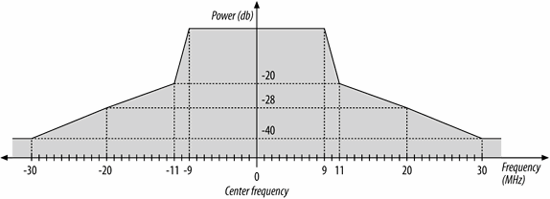
Figure 13-13 gives an overall view of the 802.11a channels available in the U.S. Four channels are available in each of the U-NII bands in the U.S. In the two lower U-NII bands, channels are allowed to overlap, and a 30-MHz guard band is present at both the lower end of the low U-NII band and the upper end of the mid U-NII band.
Figure 13-13. Operating bands from Table 13-1
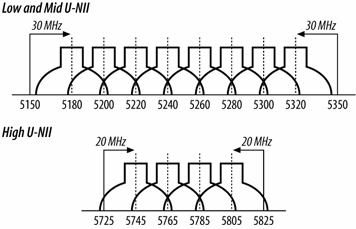
Introduction to Wireless Networking
- Introduction to Wireless Networking
- Why Wireless?
- What Makes Wireless Networks Different
- A Network by Any Other Name...
Overview of 802.11 Networks
- Overview of 802.11 Networks
- IEEE 802 Network Technology Family Tree
- 11 Nomenclature and Design
- 11 Network Operations
- Mobility Support
11 MAC Fundamentals
- 11 MAC Fundamentals
- Challenges for the MAC
- MAC Access Modes and Timing
- Contention-Based Access Using the DCF
- Fragmentation and Reassembly
- Frame Format
- Encapsulation of Higher-Layer Protocols Within 802.11
- Contention-Based Data Service
- Frame Processing and Bridging
11 Framing in Detail
- 11 Framing in Detail
- Data Frames
- Control Frames
- Management Frames
- Frame Transmission and Association and Authentication States
Wired Equivalent Privacy (WEP)
- Wired Equivalent Privacy (WEP)
- Cryptographic Background to WEP
- WEP Cryptographic Operations
- Problems with WEP
- Dynamic WEP
User Authentication with 802.1X
- User Authentication with 802.1X
- The Extensible Authentication Protocol
- EAP Methods
- 1X: Network Port Authentication
- 1X on Wireless LANs
11i: Robust Security Networks, TKIP, and CCMP
- 11i: Robust Security Networks, TKIP, and CCMP
- The Temporal Key Integrity Protocol (TKIP)
- Counter Mode with CBC-MAC (CCMP)
- Robust Security Network (RSN) Operations
Management Operations
- Management Operations
- Management Architecture
- Scanning
- Authentication
- Preauthentication
- Association
- Power Conservation
- Timer Synchronization
- Spectrum Management
Contention-Free Service with the PCF
- Contention-Free Service with the PCF
- Contention-Free Access Using the PCF
- Detailed PCF Framing
- Power Management and the PCF
Physical Layer Overview
- Physical Layer Overview
- Physical-Layer Architecture
- The Radio Link
- RF Propagation with 802.11
- RF Engineering for 802.11
The Frequency-Hopping (FH) PHY
- The Frequency-Hopping (FH) PHY
- Frequency-Hopping Transmission
- Gaussian Frequency Shift Keying (GFSK)
- FH PHY Convergence Procedure (PLCP)
- Frequency-Hopping PMD Sublayer
- Characteristics of the FH PHY
The Direct Sequence PHYs: DSSS and HR/DSSS (802.11b)
- The Direct Sequence PHYs: DSSS and HR/DSSS (802.11b)
- Direct Sequence Transmission
- Differential Phase Shift Keying (DPSK)
- The Original Direct Sequence PHY
- Complementary Code Keying
- High Rate Direct Sequence PHY
11a and 802.11j: 5-GHz OFDM PHY
- 11a and 802.11j: 5-GHz OFDM PHY
- Orthogonal Frequency Division Multiplexing (OFDM)
- OFDM as Applied by 802.11a
- OFDM PLCP
- OFDM PMD
- Characteristics of the OFDM PHY
11g: The Extended-Rate PHY (ERP)
- 11g: The Extended-Rate PHY (ERP)
- 11g Components
- ERP Physical Layer Convergence (PLCP)
- ERP Physical Medium Dependent (PMD) Layer
A Peek Ahead at 802.11n: MIMO-OFDM
11 Hardware
- 11 Hardware
- General Structure of an 802.11 Interface
- Implementation-Specific Behavior
- Reading the Specification Sheet
Using 802.11 on Windows
11 on the Macintosh
Using 802.11 on Linux
- Using 802.11 on Linux
- PCMCIA Support on Linux
- Linux Wireless Extensions and Tools
- Agere (Lucent) Orinoco
- Atheros-Based cards and MADwifi
- 1X on Linux with xsupplicant
Using 802.11 Access Points
- Using 802.11 Access Points
- General Functions of an Access Point
- Power over Ethernet (PoE)
- Selecting Access Points
- Cisco 1200 Access Point
- Apple AirPort
Logical Wireless Network Architecture
- Logical Wireless Network Architecture
- Evaluating a Logical Architecture
- Topology Examples
- Choosing Your Logical Architecture
Security Architecture
- Security Architecture
- Security Definition and Analysis
- Authentication and Access Control
- Ensuring Secrecy Through Encryption
- Selecting Security Protocols
- Rogue Access Points
Site Planning and Project Management
- Site Planning and Project Management
- Project Planning and Requirements
- Network Requirements
- Physical Layer Selection and Design
- Planning Access-Point Placement
- Using Antennas to Tailor Coverage
11 Network Analysis
11 Performance Tuning
Conclusions and Predictions
EAN: 2147483647
Pages: 179
